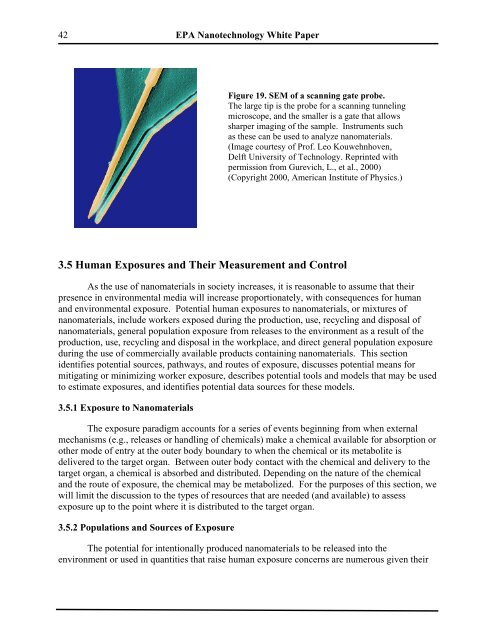Nanotechnology White Paper - US Environmental Protection Agency
Nanotechnology White Paper - US Environmental Protection Agency
Nanotechnology White Paper - US Environmental Protection Agency
You also want an ePaper? Increase the reach of your titles
YUMPU automatically turns print PDFs into web optimized ePapers that Google loves.
42 EPA <strong>Nanotechnology</strong> <strong>White</strong> <strong>Paper</strong><br />
Figure 19. SEM of a scanning gate probe.<br />
The large tip is the probe for a scanning tunneling<br />
microscope, and the smaller is a gate that allows<br />
sharper imaging of the sample. Instruments such<br />
as these can be used to analyze nanomaterials.<br />
(Image courtesy of Prof. Leo Kouwehnhoven,<br />
Delft University of Technology. Reprinted with<br />
permission from Gurevich, L., et al., 2000)<br />
(Copyright 2000, American Institute of Physics.)<br />
3.5 Human Exposures and Their Measurement and Control<br />
As the use of nanomaterials in society increases, it is reasonable to assume that their<br />
presence in environmental media will increase proportionately, with consequences for human<br />
and environmental exposure. Potential human exposures to nanomaterials, or mixtures of<br />
nanomaterials, include workers exposed during the production, use, recycling and disposal of<br />
nanomaterials, general population exposure from releases to the environment as a result of the<br />
production, use, recycling and disposal in the workplace, and direct general population exposure<br />
during the use of commercially available products containing nanomaterials. This section<br />
identifies potential sources, pathways, and routes of exposure, discusses potential means for<br />
mitigating or minimizing worker exposure, describes potential tools and models that may be used<br />
to estimate exposures, and identifies potential data sources for these models.<br />
3.5.1 Exposure to Nanomaterials<br />
The exposure paradigm accounts for a series of events beginning from when external<br />
mechanisms (e.g., releases or handling of chemicals) make a chemical available for absorption or<br />
other mode of entry at the outer body boundary to when the chemical or its metabolite is<br />
delivered to the target organ. Between outer body contact with the chemical and delivery to the<br />
target organ, a chemical is absorbed and distributed. Depending on the nature of the chemical<br />
and the route of exposure, the chemical may be metabolized. For the purposes of this section, we<br />
will limit the discussion to the types of resources that are needed (and available) to assess<br />
exposure up to the point where it is distributed to the target organ.<br />
3.5.2 Populations and Sources of Exposure<br />
The potential for intentionally produced nanomaterials to be released into the<br />
environment or used in quantities that raise human exposure concerns are numerous given their

















